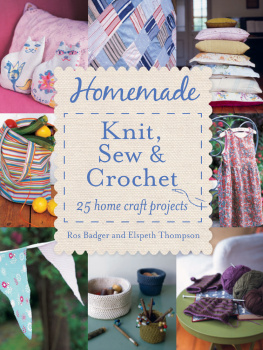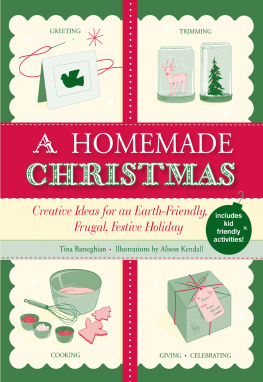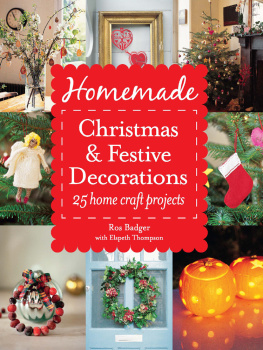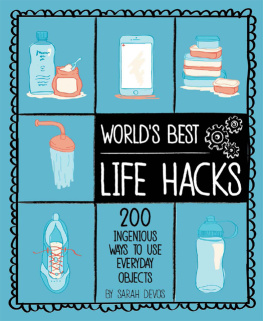To my beloved friend Elspeth who I will always miss. Also to our mothers, Margaret and Ruth, and daughters Martha, Ceidra and Mary, who are a continuing source of inspiration.
Contents
There was a time, not so very long ago, when the term homemade was synonymous with dowdiness and doing without. From the profligate 1980s on, shopping seemed to become the preferred national pastime, while making your own was seen as second-best, an eccentricity, or a leftover from childhood TV programmes. But a few years ago a gradual shift began to occur. There was a revival of the old crafts combined with a new energetic approach. Knitting and crochet were suddenly in the zeitgeist and popular again, and everyone from New York bankers to teenage schoolgirls seemed to be starting crafts clubs.
Interest in craft has been growing among all sorts of groups and ages, and many people are now keen to make things for themselves, family and friends. The childrens sewing club Sew Good, which I teach in the UK, has a long waiting list and I am inundated with people wanting to learn how to knit, sew and crochet. Many women now want to explore their creativity and make something stylish for the home, especially given the ever-growing interest in individual, handcrafted objects. My students are hugely diverse, from homemakers and business executives to children and other artisans. Recently an ber-cool male student, studying Japanese, asked me to teach him how to crochet!
The homemade movement has gained an added energy and momentum from the two major crises environmental and financial that now face us all. Making and growing things not only saves money and helps the environment, the activities themselves give rise to a feel-good factor that can help cheer us up in adversity. Our homes become havens in times of global uncertainty, and knowing that we have the skills and resources to make things of use and beauty for those we live around and love without costing the earth can be a source of great comfort and pleasure.
My aims with this book are the same as they have always been to spread the joy of creating and making things yourself, and to share that with others. Creating something is a satisfying and fulfilling thing to do and has been a constant in my life. Having been taught to crochet by my grandmother at the age of seven, I wore homemade clothes that my mother made for me as a child and then started to sew and knit my own designs as a teenager, not only because it was an economical way to live but because I was able to establish my individual style. This is still a vital part of my own creative process and one that I was lucky enough to turn into a career.
This book offers a range of stylish projects with something for everyone using a variety of skills, many requiring little experience. It does, however, require an alternative mindset to many craft books, which often start by listing stuff to buy, whereas I think half the fun lies in saving materials wherever you can, from fabric and buttons taken off favourite old clothes or furnishings, to ribbon from unwrapped presents. As these saved and salvaged materials become stitched and woven into new objects, the backdrop to our lives gathers texture and richness, with added layers of memory and association.
I have always been proud to be seen as a creative person, but now we are firmly back to a time where craft is not the preserve of an envied talented few, but widespread across the globe. Homemade (including homegrown) has become a way of life for a huge number of people. So many people can now be heard saying with pride, I made it myself! People are no longer happy with doing the odd bit of knitting on their commuter train or taking a homemade gift to a party they want to live the life, and embrace the authenticity and love behind everything homemade.
The increasing number of books, blogs and websites that have appeared over the last couple of years extolling the virtues of all things homemade give me hope that this wonderful trend is here to stay.
Ros Badger
iPod cover
Precious iPods look even better tucked inside gorgeous homemade covers. This pattern is simple enough for novice knitters, and can be customised by varying the colour or design in subtle or bold ways.
You will need
- 4-ply cotton, approximately 10g (oz) (we used mercerised cotton, which has a slight sheen and washes well)
- 2.75mm (UK size 12; US size 2) knitting needles
- 2.5mm crochet hook (if making optional strap)
Tension over stocking stitch
16sts and 22 rows = 5cm (2in)
Measurements
7 8.5cm (2 3in)
To make an iPod Nano cover
With 2.75mm (UK size 12; US size 2) needles and the 4-ply cotton, cast on 22sts and work 8 rows in garter st (knit every row) then work in stocking st (knit one row, purl one row) until the cover measures 15cm (6in).
Work 8 rows garter st and cast off.
Fold the bag in half, right sides together, sew the two side seams and then turn through.
To make an iPod classic or other MP3 player cover
Measure your player and, using the , work out how many sts you need for the width, then add 4 more sts.
With 2.75mm (UK size 12; US size 2) needles, cast on the required number of sts and work 8 rows garter st, then work in stocking st until the piece measures twice the length of your player. Work 8 more rows of garter st and cast off. Fold the bag in half, right sides together, sew the two side seams and then turn through.
To make the strap
The simplest way to make a strap is to attach a colourful piece of ribbon. However, if you know how to crochet, the following instructions explain how to make a strong, pretty strap.
With the 2.5mm crochet hook and 4-ply cotton, make a 30cm (12in) long single chain.
Thread this through the knitted bag just below the garter st top. There is no need to make eyelet holes as the chain can easily be threaded through between the knitted sts. Tie together the loose ends to make a loop.
Tea cosy
As well as keeping your tea hot, a homemade tea cosy brings an air of warmth and originality to the kitchen table. Choose colours that work with your cups and kitchen dcor.
You will need
- About 60g (2oz) yarn (this was knitted using Aran tweed but any Aran yarn would also work)
- Yarn scraps in contrasting colours for the embroidery and pompom
- 4.5mm (UK size 7; US size 7) needles (you can change the needle size to make the cosy larger or smaller; the one pictured fits a six-teacup teapot)
Tension
10sts and 12 rows = 5cm (2in)
To make
With 4.5mm (UK size 7; US size 7) needles and yarn, cast on 84sts and work 5 rows to form the border.
Row 1: Knit.
Row 2: Purl.
Repeat these 2 rows once more then divide (work for spout and handle).
Row 5: K42 and keep remaining sts on a stitch holder.
Row 6: K2, p38, k2.
Repeat the last 2 rows 10 times more, ending on a purl row. Keep these sts on a stitch holder and repeat on the opposite side until the work measures the same front and back. End on a purl row.
Next row: Knit across the whole work.
Next row: Purl.
Then start decreasing as follows:
Row 1: K11, k2tog, * k12, k2tog *, repeat from * to * 5 times, k1. (78sts)
Row 2: Purl.
Row 3: K10, k2tog, * k11, k2tog*, repeat from * to * 5 times, k1. (72sts)









